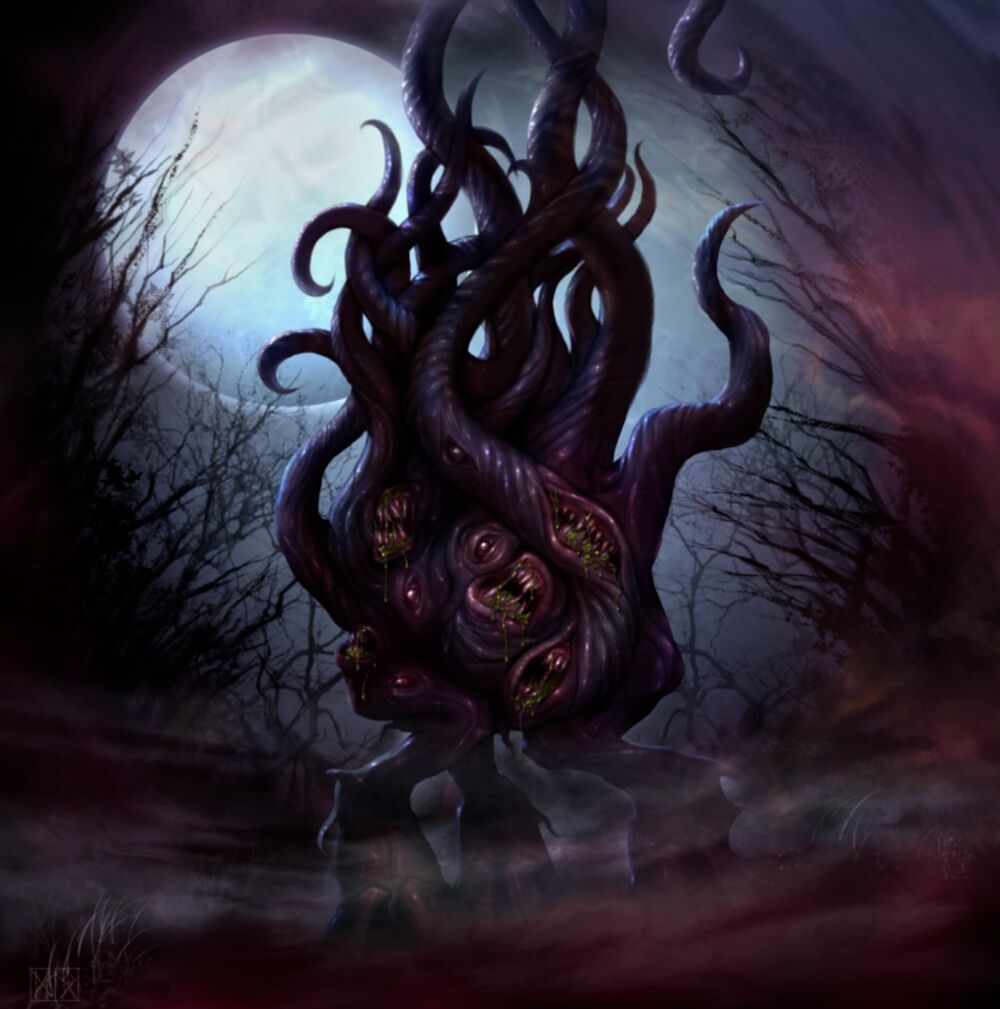Kalabon
"My little pets are a good reminder of what happens when hags rise above their station. As a bonus, they do so love to eat my inconvenient garbage."
~Nereia Zazerac
Basic Information
Anatomy
Individual kalabons have three legs, raw, oozing flesh, tentacles, and gaping maws. Kalabon colonies are a little more varied, anywhere from 6 feet to 60 feet in height.
Genetics and Reproduction
Kalabons were born when the Hag-Countess was assassinated by Glasya, Princess of Hell. The final agonies of the old ruler of Malbolge were so great that individual cysts and tumors tore free from her tortured flesh and became the first kalabons. New kalabons are crafted from the very soil and clay of Malbolge, which itself was a part of the Hag Countess. While this can happen spontaneously, it's more often a product of a profane ritual to create a miserable, self-loathing servant.
Growth Rate & Stages
Kalabons are quite short when they're made, 3-4 ft. tall. They don't naturally grow, but they combine into larger versions of themselves. At any point, they can tear themselves apart into the individual kalabons. There is no known maximum size, but the largest attested in mythology and folklore was around 60 feet.
| Name | Constituent Members | Size | Height | HP (6xConstituent Members) | Melee | AC |
|---|---|---|---|---|---|---|
| Individual Kalabon | 1-3 | Small | 3-4 | 6-18 | tentacle +4 (1d4+1 plus 1d3 acid) | 14 |
| Cyst | 4-7 | Medium | 4-8 | 24-42 | 2 tentacles each+5 (1d6 plus 1d4 acid) | 13 |
| Polyp | 8-31 | Large | 8-16 | 48-186 | 3 tentacles each +6 (1d8 plus 1d6 acid) | 12 |
| Colony | 32-50 | Huge | 16-32 | 192-300 | 4 tentacles each +17 (2d6 plus 1d8 acid) | 11 |
| Colossus | 51+ | Gargantuan | 32+ | 306+ | All creatures within 30 ft. of a kalabon colossus at the start of their turns must make a Dexterity Save or take 4d6 bludgeoning plus 1d12 acid, taking half on a successful save. | 10 |
Ecology and Habitats
Kalabons can't thrive anywhere but perfectly silent, perfectly dark places. Such places are rare in the extremes required to cause a kalabon no pain, but they are typically found in places that approach these traits such as deep caves and root cellars of abandoned rural hovels. Not being native to Kobos, they are only found when they have been intentionally summoned or crafted.
Dietary Needs and Habits
In Malbolge, Kalabons devour souls like any Devil, but those on the Prime Material are obligate carnivores with very little preference for what sort of meat they consume.
Additional Information
Social Structure
Kalabons are in constant pain from any sensation whatsoever, save one. They feel a small measure of peace and relief when they gather together, joining their bodies into colonies. This makes them feel just a tiny sliver of what it was like to be part of the Hag Countess, and if they had a goal as a species it would be to join all of themselves together and remake the Hag Countess once again.
Uses, Products & Exploitation
All kalabons everywhere are ultimately the slaves of Glasya, as she has laid claim to every ounce of their flesh. In practice, they often serve her minions as guardians, executioners, and corpse disposers.
Perception and Sensory Capabilities
Kalabons can detect light, smell, taste, heat, and sound through their slimy flesh. They find this extremely unpleasant and will seek to either flee from or destroy sources of large sensation quickly.
Kalabons are telepathic, and can establish weak links with non-kalabons while their own minds mingle into one basic intelligence within range.
Civilization and Culture
Naming Traditions
Kalabons are all Malagard. They can't think of themselves as individuals, they are in too much pain, but occasionally their delegated masters assign them names. By tradition these are always insulting.
Major Organizations
The largest delegated master of kalabons on Kobos is Nereia Zazerac and by extension her cult.
Major Language Groups and Dialects
Kalabons speak Infernal
History
Malbolge is the sixth layer of the Nine Hells of Baator. Once, it was the domain of the Hag Countess Malagard, who herself had acquired it for betraying the previous duke, Moloch, to Asmodeus. She used her position to prepare a ritual to ascend to godhood, a process that would require her to consume millions of souls. After millennia of preparation, she was betrayed during the ritual by Glasya who had either altered the ritual or poisoned the souls to foul the process. Malagard swelled to impossible size and split into pieces, her twisted body serving as landmarks in the domain that Glasya now ruled.
It was from this screaming flesh that the first kalabons erupted, tearing free to avoid Malagard's fate. These polypous devils were enslaved by Glasya, who enjoys using them as much to further her own plans as torturing what was left of Malagard.
Genesis Ritual, Page 751 of the Gahapi Czangbuyag
Individual Kalabon
Kalabon Cyst
Kalabon polyp
Instructions on the control of a kalabon colony, Page 752 of the Gahapi Czangbuyag
Kalabon Colossus










Comments